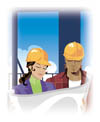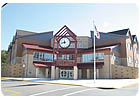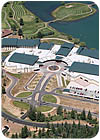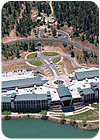Cool Roofing: LEED and Metal Roofing

Metal roofs have long been popular with architects for their dramatic appearance and long-term performance characteristics, particularly their low maintenance costs and durability. With the concept of sustainability now being widely embraced by the architectural community, metal roofs are being seen in a new light. Metal roofing can contribute significantly to the sustainable building movement. Their high recycled content, total recyclability and energy efficiency allow "cool metal roofs" to qualify for points in the Energy Star and Leadership in Energy and Environmental Design (LEED) Green Building Rating System programs.
Used as a guide toward environmental design, LEED (www.leedbuilding.org) uses a credit or point system to establish an overall building performance. Rating points are given for various sustainable features in five categories: building site; water efficiency; energy and atmosphere; materials and resources; and indoor environmental quality. Ratings are based on the number of points earned. For new construction, a building needs at least 52 points out of a total of 69 to reach the platinum level (the highest rating). In descending order, the other levels include gold (39 to 51 points), silver (33 to 38 points) and certified (26 to 32 points).
The LEED program can result in economic and social incentives to building environmentally sound buildings, and metal roofing may offer a path to earning those incentives.

Cool Roof Savings
Cool roofs can reduce heat transfer to the indoor environment, thereby lowering air conditioning costs. Studies monitoring buildings in California and Florida demonstrate that cool roofs save residents and building owners 20 to 70 percent in annual cooling energy use, and cool metal roofing can qualify for tax incentives and earn LEED credits.According to LEED, Credit 7.2 is designed to "reduce heat islands (thermal gradient differences between developed and undeveloped areas) to minimize impact on microclimate and human and wildlife habitat." The credit is worth one point.
The temperatures in the air above heat islands can be as much as 12 degrees Fahrenheit hotter than the surrounding suburbs, leading to higher air conditioning costs, greater use of electricity and higher levels of smog and ozone.
Department of Energy research has shown that one additional percent of reflectivity in a roof coating on average will reduce the roof temperature by one degree. The ultimate result is that heat is reflected away from buildings, smog is reduced, energy costs are lowered and the life expectancy of the roof will be increased due to less expansion and contraction.
Cool roofs reflect heat well across the entire solar spectrum, especially in the infrared and visible wavelengths. In addition to absorbing less heat, the coolest roofing materials radiate away any absorbed heat.
Regardless of the kind of material used, cool roofs have two important surface properties: a high solar reflectance and a high thermal emittance. Solar reflectance, also called albedo, is a measure of the ability of a surface material to reflect sunlight - including the visible, infrared, and ultraviolet wavelengths - on a scale of 0 to 1, which can be expressed as a decimal fraction (0.7) or a percentage (70 percent). Essentially, it is the percentage of solar energy that is reflected by a surface.
Thermal emittance is defined as the percentage of energy a material can radiate away after it is absorbed. It is the ability to release absorbed heat. Scientists use a number between 0 and 1 (or a percentage) to express emittance.
Solar reflectance and thermal emittance have noticeable effects on temperature. Some conventional roof surfaces have low reflectance (from 5 percent to 25 percent) and high thermal emittance (typically over 80 percent). These surfaces can heat up to 150 to 190 degrees Fahrenheit at midday during the summer. Bare metal or metallic surfaced roofs often have a high solar reflectance (typically 50 percent or higher) and may have low thermal emittance (anywhere between 2 percent to 66 percent), depending on their surface treatment. These surfaces warm to 140 to 170 degrees Fahrenheit. Cool roofs with both high reflectance and high emittance warm to only 100 to 120 degrees Fahrenheit in the summer sun.
Energy Star Program
The Environmental Protection Agency's Energy Star Roof Product Program (www.energystar.gov) has cool roofing specifications for both low-sloped and sloped roofs. Low-sloped roofs (those below 2:12) and flat roofs must have an average initial albedo of at least 0.65, and steep sloped roofs must have an average initial albedo of 0.25 or more.Under new LEED Version 2.2 requirements approved Oct. 31, 2005, roofing materials used on low slope roofs with a slope of less than 2:12 must now meet a solar reflectance index (SRI) of 78, while steep-sloped roofs with a slope of more than 2:12 must have an SRI of 29.
According to these new requirements, an SRI is defined as "a measure of the constructed surface's ability to reflect solar heat as shown by a small temperature rise. It is defined so that a standard black with reflectance of 0.05 and emittance of 0.90 is zero (0) while the SRI for a standard white (reflectance of 0.80 and emittance 0.90) is 100."
To calculate the SRI for a given material, it is necessary to obtain the reflectance and emittance values for the material. SRI is calculated according to ASTM E 1980. This is a standard practice for calculating the solar reflectance index of horizontal and low-sloped opaque surfaces with emissivity greater than 0.1. Reflectance is calculated according to any one of three ASTM standards - ASTM E 903, ASTM E 1918 or ASTM C 1549. Emittance is calculated according to ASTM E 408 or ASTM C 1371.

Cool Colors
Tests have shown that on a 90-degree day, a white roof will only have a temperature of 110 degrees at its surface while a black roof will have a reading of 190 degrees. However, it would be a very dull country if architects and builders could not enhance the appearance of their products and were restricted to white, despite the energy savings. Consequently, roof coatings manufacturers have been developing cool roof coatings that increase heat reflectivity and reduce emissivity without sacrificing color choices.New infrared-reflective pigments incorporated into paints used on architectural metal roofing products allow them to achieve higher reflectivity values, even in darker colors such as black and brown. This improved reflectivity - the reflectivity for black, for example, changes from 0.07 with normal pigments to 0.32 with infrared-reflective pigments - can mean a much cooler surface temperature and greater energy savings for the building below. This allows facility executives to select a sustainable roof without having to sacrifice aesthetics.
Research shows that most of the cool roof coatings and colors available today have little or no trouble meeting the reflectivity standards for the LEED and Energy Star programs. Some, however, would fall short in meeting emissivity requirements if the entire roof surface required it.
However, utilizing the weighted average calculation as defined by LEED in one of its recent Credit Interpretation Rulings (CIR), only 75 percent of the roof surface must have 0.90 emissivity; the remaining 25 percent can be anything. There are many LEED Credit Interpretations Rulings that have allowed a lower emissivity or solar reflectance - but not both - where 100 percent of the roof surface is covered by one material, including a painted metal.
This means any prepainted metal covering 100 percent of the roof, meeting the Energy Star Solar Reflectance specification, and having a thermal emittance of 0.70 or greater, meets or exceeds the LEED 7.2 credit criteria.
These Credit Interpretation Request (CIR) rulings can be critical when planning a LEED-compliant building. They are available from the U.S. Green Building Council in a catalog of questions formally asked of the Council by registered LEED projects. CIR rulings, once published, apply to all subsequent projects, and provide important guidance not found in the LEED reference manual.
Energy Performance
Most industry experts agree that reflectivity has a greater impact than emissivity on the energy performance of the roof during hot weather. If a majority of the initial solar radiation is reflected, then a smaller portion is left for infrared emittance. Many cool roofs have reflectivities of 75 to 80 percent, which means that only 20 to 25 percent of the sun's energy is absorbed into the roof.According to the Lawrence Berkeley National Laboratory, at an ambient temperature of 98 degrees, a change in a roof's emissivity from 0.75 to 0.90 while keeping reflectivity constant results in a surface temperature reduction of two degrees. Conversely, raising a roof's reflectivity from 0.25 to 0.40 while keeping emissivity constant results in a surface temperature reduction of 13 degrees, a substantial difference.
Still, the combination of high reflectivity and high emissivity during hot summer months results in a surface temperature sometimes as much as 60 to 70 degrees cooler than a nonreflective roof. The reduction in heat energy means less need for air conditioning and lower energy costs.
Product Compliance
How do roof and roof coatings manufacturers gain LEED compliancy? It must be made clear that the U.S. Green Building Council does not certify products, but only buildings, in the LEED program. However, products and their manufacturers can meet standards to become designated as compliant with Energy Star or LEED programs. For example, a product might verify claims that it can contribute to earning LEED points in a particular category.In the case of Energy Star and LEED, a qualified laboratory can determine the solar reflectance required by the program. The laboratory does not need to be independent of the material manufacturer; therefore both third party and manufacturer laboratories can be used to provide data to the EPA.
However, the Cool Roof Rating Council (CRRC), an independent, nonprofit industry association, requires that the laboratory conducting the measurement be accredited. Either the lab must be listed as an Accredited Independent Testing Laboratory (AITL) by the CRRC or it must be an Accredited Manufacturers Testing Laboratory (AMTL) to perform the tests to determine reflectivity and emissivity. Both the AITL and the AMTL must meet the requirements of the CRRC, which includes ISO certification of the lab, as well as additional required CRRC training.

Recyclability
While the most widely known LEED credit for roofing is for the heat island effect, metal's high recycled content, its total recyclability and its smooth, impervious surface allow metal to meet requirements for other points in the LEED program as well.Metal is the world's most recycled material. Iron, including its refined product steel, is the most widely used of all the metals, and the recycling of iron and steel scrap (ferrous scrap) is an important activity worldwide. Because it is economically advantageous to recycle iron and steel by remelting and casting for use in the manufacture of new steel products, a significant industry has developed to collect old scrap including used and obsolete iron and steel products, and new ferrous scrap generated in steel mills and steel-product manufacturing plants. The North American steel industry's overall recycling rate is 71 percent, according to the Steel Recycling Institute.
Consequently, the content of steel, aluminum and copper metal roofing material is comprised of substantial amounts of recycled materials, making them excellent candidates to be considered for the LEED credits focused on recycled materials, including Materials and Resources (MR) Credit 4.1 for Recycled Content. The credit calls for the use of materials with recycled content such that the sum of post-consumer recycled content plus one-half of the pre-consumer recycled content constitutes at least 10 percent of the cost of the total value of the materials in the project. The recycled content value of material assembly is based on weight. The recycled fraction of the assembly is then multiplied by the cost of assembly to determine the recycled content value.
The project gets one LEED credit for meeting the qualifications and can pick up an additional credit if the sum of post-consumer recycled content plus one-half the pre-consumer content constitutes an additional 10 percent or a total of 20 percent based on cost.
Most steel sheet products are produced through the basic oxygen furnace process, which uses 25 to 35 percent old steel to make new steel. Figures for pre-consumer and post-consumer recycled scrap may vary slightly at individual furnaces making steel around the country. And architects and builders will certainly want to ask their roofing material supplier to provide them from their furnace source.
Aluminum is also recycled extensively from both post-consumer and pre-consumer sources. According to the Aluminum Association, a survey in late 2003 indicated that the recycled content of domestically produced, flat-rolled products for the building and construction market was approximately 80 percent to 85 percent. Aluminum Alloy 3105, the aluminum product used in nearly every aluminum standing seam roofing application is produced from 99 percent scrap, 80 percent of which is from post-consumer sources. The aluminum coil used comes from state of the art, scrap based aluminum mini-mills, producing a variety of common alloy sheet. And the association notes that in addition, at the end of its long, useful life, aluminum roofing can be repeatedly recycled back into similar products with no loss of quality.
Copper also is a routinely recycled metal with the highest scrap value of any building metal. Copper's high cost makes it a favored product for collection and sale to nonferrous-scrap recycling companies. The average recycled content of all copper products is 44.6 percent. Copper roofing, contains 75 percent scrap. Almost 50 percent of this is post-consumer scrap.
Regional Materials
The other primary credit associated with metal roofing reuse and recyclability is MR Credit 5.1 for Regional Materials where 10 percent are extracted, processed and manufactured regionally. This regulation differs substantially from the old LEED requirement for credit, first in the percentages required and second in the way the qualified building material is defined.The new LEED requirement calls for the material to be "extracted, harvested or recovered as well as manufactured within 500 miles of the project site." The new requirement reinforces LEED's intent to reduce environmental impacts resulting from the transportation of materials. It also puts the burden on a project sponsor to make certain that any metal used in a roof meets the two criteria - extracted, harvested or recovered and manufactured within 500 miles.
The old requirement that allowed assembly to be the final point of manufacture no longer holds true under the 2.2 requirement. Consequently, anyone seeking the credit should ask the metal roofing supplier to provide proof of where the metal substrate was manufactured and if it is within 500 miles of the project location. Roofing material manufacturers are requiring their metal substrate manufacturer to help them map out specifically the history of the material resources.
Documentation and Other Challenges
Trying to track down material resources including the substrate manufacturer's information on recycled content or location of manufacture can be challenging. Some metal roofing manufacturers who have been working with LEED projects and architects are aware of this need and have the information, including letters and other forms of verification from substrate manufacturers. Conversely, architects and developers submitting LEED projects should include in the spec and bid packages clear direction to a roofing manufacturer what point of manufacture will be required of team members and their vendors.Metal roofing may play an indirect role in qualifying for other LEED credits as well. For example, roofing materials figure in MR Credit 1.1 and 1.2 for Building Reuse, which are intended to extend the life cycle of existing building stock and reduce waste and the environmental impacts of new buildings. The use of metal roofing material might be designed to play an integral role in other credit classifications involving the conservation of water resources, including reclaiming and reusing non-potable water.
Ultimately, metal roofing presents architects and builders with an opportunity to use the products' sustainable attributes in a LEED project. When amassed with other rating points for various sustainable features, metal can be a simple and cost-effective way to meet program requirements.
Looking for a reprint of this article?
From high-res PDFs to custom plaques, order your copy today!


